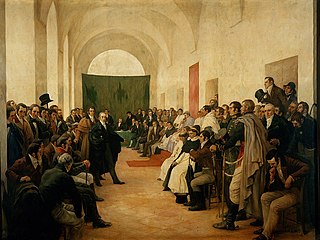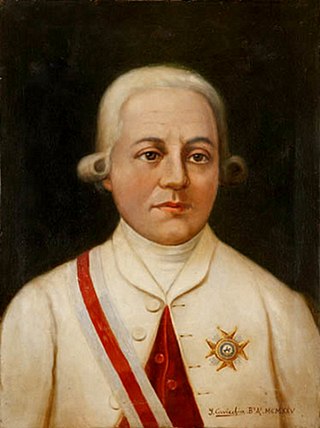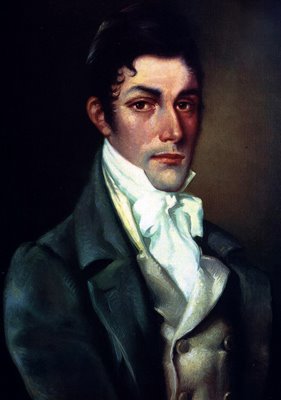
The Argentine War of Independence was a secessionist civil war fought from 1810 to 1818 by Argentine patriotic forces under Manuel Belgrano, Juan José Castelli, Martin Miguel de Guemes and José de San Martín against royalist forces loyal to the Spanish crown. On July 9, 1816, an assembly met in San Miguel de Tucumán, declaring independence with provisions for a national constitution.

Juan Martín de Pueyrredón y O'Dogan was an Argentine general and politician of the early 19th century. He was appointed Supreme Director of the United Provinces of the Río de la Plata after the Argentine Declaration of Independence.

The May Revolution was a week-long series of events that took place from May 18 to 25, 1810, in Buenos Aires, capital of the Viceroyalty of the Río de la Plata. This Spanish colony included roughly the territories of present-day Argentina, Bolivia, Paraguay, Uruguay, and parts of Brazil. The result was the removal of Viceroy Baltasar Hidalgo de Cisneros and the establishment of a local government, the Primera Junta, on May 25.

Santiago Antonio María de Liniers y Bremond, 1st Count of Buenos Aires, KOM, OM was a Spanish military officer and a viceroy of the Viceroyalty of the Río de la Plata. Although born Jacques de Liniers in France, he is more widely known by the Spanish form of his name.

The British invasions of the River Plate were two unsuccessful British attempts to seize control of the Spanish colony of the Viceroyalty of the Río de la Plata, located around the Río de la Plata in South America – in present-day Argentina and Uruguay. The invasions took place between 1806 and 1807, as part of the Napoleonic Wars, at a time when Spain was an ally of Napoleonic France. In Argentine historiography, the two successive defeats of the British expeditionary forces are known collectively as the "Reconquista" and the "Defensa", respectively.
The military history of Argentina spans a period of over two centuries. During the course of those years, it broke colonial ties with Spain, waged a civil war to define its organization and wars with Brazil, Paraguay, Britain and France. The military also played a role in the institutional life of the country, during a series of coups d'état that took place in the 20th century.

Baltasar Hidalgo de Cisneros y de la Torre was a Spanish naval officer born in Cartagena. He took part in the Battle of Cape St Vincent and the Battle of Trafalgar, and in the Spanish resistance against Napoleon's invasion in 1808. He was later appointed Viceroy of the Viceroyalty of the Río de la Plata, replacing Santiago de Liniers. He disestablished the government Junta of Javier de Elío and quelled the Chuquisaca Revolution and the La Paz revolution. An open cabildo deposed him as viceroy during the May Revolution, but he attempted to be the president of the new government junta, thus retaining power. The popular unrest in Buenos Aires did not allow that, so he resigned. He was banished back to Spain shortly after that, and died in 1829.

Don Rafael de Sobremonte y Núñez del Castillo, 3rd Marquis of Sobremonte, third Marquis of Sobremonte, was an aristocrat, military man and Spanish colonial administrator, and Viceroy of the Río de la Plata. He was accused of cowardice by the people of Buenos Aires after escaping the city during the British invasions of the Río de la Plata in 1806.

Martín de Álzaga was a Spanish merchant and politician during the British invasions of the Río de la Plata.

The 1st Infantry Regiment "Los Patricios" is the oldest and one of the most prestigious regiments of the Argentine Army. The title is often shortened to the Patricians' Regiment. Since the 1990s the regiment has been designated as air assault infantry. It is also the custodian of the Buenos Aires Cabildo, the welcoming party for visiting foreign dignitaries to Argentina and the escort, and honor guard battalion for the City Government of Buenos Aires. Since 22 September 2010, the Regiment's headquarters building has been a National Historical Monument following a declaration by the Argentine government on the occasion of the country's bicentennial year.

Juan Hipólito Vieytes, was an Argentine merchant and soldier. He was the son of Juan Vieytes and Petrona Mora Fernández de Agüero. His family's house was at 133 Calle Real in front of the central square.

Domingo Bartolomé Francisco Matheu was a Spanish-born Argentine businessman and politician. He was a member of the Primera Junta, the first national government of modern Argentina, and the second president in the end of the Junta Grande from August to September 1811.

The Liniers counter-revolution took place in the Spanish Viceroyalty of the Río de la Plata after the May Revolution in 1810. The former viceroy, Santiago de Liniers, led an ill-fated counter-revolutionary attempt from the city of Córdoba, and it was quickly frustrated by the patriotic forces of the newly formed Army of the North. Francisco Ortiz de Ocampo, the leader of the Army of the North, captured the leaders and dispatched them to Buenos Aires as prisoners, but, on the orders of the Primera Junta, they were intercepted and executed before arrival.

La Reconquista de Buenos Aires is an Argentine historical painting by Charles Fouqueray in 1909. It depicts the victory of Santiago de Liniers against William Carr Beresford during the first of the British invasions of the Río de la Plata, and the subsequent liberation of Buenos Aires from British rule. It was made in the proximity of the Argentina Centennial.

Lucio Norberto Mansilla was an Argentine soldier and politician. He was the first governor of the Entre Ríos Province and fought in the battle of Vuelta de Obligado.

The Argentine War of Independence was fought from 1810 to 1818 by Argentine patriotic forces under Manuel Belgrano, Juan José Castelli and José de San Martín against royalist forces loyal to the Spanish crown. On July 9, 1816, an assembly met in San Miguel de Tucumán, declared full independence with provisions for a national constitution.

The Battle of Cardal, on 20 January 1807, was the main conflict between the Spanish defense forces of Montevideo, Uruguay, and British troops during the siege of Montevideo during the second British invasion of the River Plate. The British won an easy victory over the outnumbered opposing forces, which paved the way for the fall of the city,

Manuel Canaveris was an Argentine army officer, who took part in the defense and reconquest of Buenos Aires during the English Invasions. He served under Colonel Ignacio Álvarez Thomas in the 4th Regiment of Buenos Aires, participating in the Campaigns to the Interior of the Provinces of 1810.
Marie Anne Périchon de Vandeuil (1775-1847), known as la Perichona, was a French noblewoman, who had an active role in the politics of Buenos Aires during the last year's of Spanish rule over the Viceroyalty of the Río de la Plata.

Battle of Miserere occurred during the second British invasion of the Río de la Plata between the British troops at the command of John Whitelocke, and the Spanish forces commanded by Santiago de Liniers. The confrontation took place on 2 July 1807 in the current Miserere square, Balvanera neighborhood, city of Buenos Aires.
















